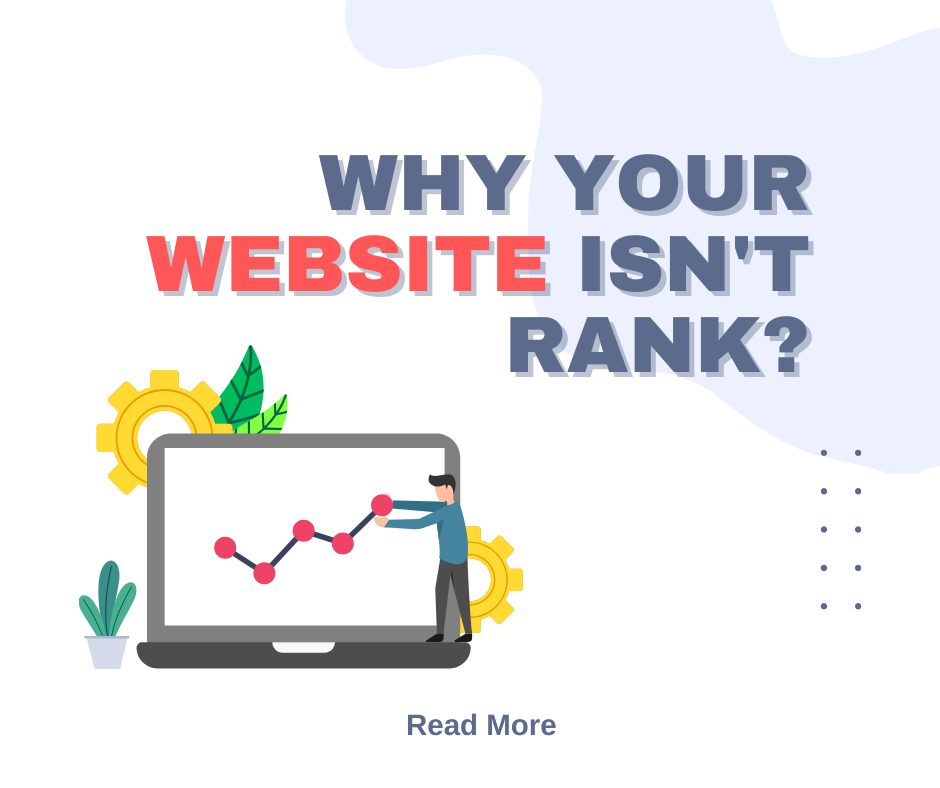Introduction
If your website not ranking on Google despite your best efforts, you’re not alone. Millions of websites struggle to achieve visibility in search results, leaving business owners frustrated and wondering what they’re doing wrong. The reality is that Google’s algorithm considers over 200 ranking factors, and even small oversights can significantly impact your search performance.
Understanding why your website isn’t ranking is the first step toward fixing the problem. From technical SEO issues to content quality problems, various factors can prevent your site from appearing in search results. The good news? Most ranking issues are fixable with the right approach and consistent effort.
This comprehensive guide will reveal the most common reasons websites fail to rank and provide actionable solutions to improve your Google visibility. Whether you’re a business owner, marketer, or website developer, these strategies will help you diagnose and resolve your ranking challenges.
What Is Google Ranking and Why Does It Matter?
Google ranking refers to your website’s position in search engine results pages (SERPs) when users search for relevant keywords. Higher rankings mean greater visibility, more organic traffic, and increased opportunities for conversions.
Google’s algorithm evaluates websites based on relevance, authority, and user experience signals. The search engine aims to provide the most helpful, accurate, and trustworthy results for each query. Understanding this fundamental principle is crucial for improving your website’s performance.
When your website doesn’t rank well, you miss out on valuable organic traffic. Studies show that the first page of Google captures over 90% of search traffic, with the top three results receiving the majority of clicks. This makes ranking optimization essential for online success.
The ranking process involves crawling, indexing, and ranking phases. Google’s bots discover your content, analyze its relevance and quality, then determine its position relative to competing pages. Issues in any of these phases can prevent your website from ranking effectively.
7 Proven Ways to Fix Your Website Not Ranking on Google
1. Conduct Comprehensive Technical SEO Audit
Technical SEO forms the foundation of your website’s search performance. Start by checking your site’s crawlability using Google Search Console. Look for crawl errors, broken links, and pages blocked by robots.txt.
Page speed significantly impacts rankings. Use Google PageSpeed Insights to identify performance issues. Optimize images, minify CSS and JavaScript, and consider upgrading your hosting plan if necessary. Mobile-friendliness is equally important, as Google uses mobile-first indexing.
Check your site’s SSL certificate and ensure all pages load securely via HTTPS. Mixed content issues can harm your rankings and user trust. Create and submit an XML sitemap to help Google discover and index your pages efficiently.
2. Optimize On-Page SEO Elements
Title tags and meta descriptions are crucial ranking factors. Include your target keywords naturally in title tags while keeping them under 60 characters. Write compelling meta descriptions that encourage clicks and accurately describe your content.
Header tags (H1, H2, H3) help structure your content and signal topic relevance to Google. Use your primary keyword in the H1 tag and related keywords in subheadings. Internal linking distributes page authority and helps Google understand your site’s structure.
Optimize your URL structure by using descriptive, keyword-rich slugs. Avoid generic URLs like “page1.html” in favor of meaningful paths that reflect your content’s topic.
3. Create High-Quality, Relevant Content
Content quality is paramount for Google rankings. Focus on creating comprehensive, valuable content that addresses user search intent. Research your target keywords thoroughly and understand what users are actually looking for.
Avoid thin content and duplicate pages. Each page should offer unique value and cover topics in sufficient depth. Use your target keywords naturally throughout the content, but prioritize readability and user experience over keyword density.
Update your content regularly to maintain freshness and relevance. Google favors websites that consistently publish new, valuable information. Consider adding blog sections or resource pages to demonstrate ongoing expertise in your field.
4. Build Authoritative Backlinks
Backlinks remain a critical ranking factor, but quality matters more than quantity. Focus on earning links from reputable, relevant websites in your industry. Guest posting, digital PR, and creating linkable assets are effective strategies.
Avoid purchasing low-quality links or participating in link schemes, as these can result in penalties. Instead, create valuable resources that naturally attract links from other websites. Infographics, original research, and comprehensive guides often earn organic backlinks.
Monitor your backlink profile using tools like Google Search Console or third-party SEO platforms. Disavow toxic links that could harm your rankings and focus on building relationships with authoritative websites in your niche.
5. Improve User Experience Signals
Google considers user experience signals when determining rankings. Reduce bounce rates by ensuring your content matches search intent and provides immediate value. Improve navigation to help users find relevant information quickly.
Core Web Vitals are essential ranking factors. Optimize Largest Contentful Paint (LCP), First Input Delay (FID), and Cumulative Layout Shift (CLS) to provide better user experiences. These metrics measure loading speed, interactivity, and visual stability.
Ensure your website is accessible across all devices and browsers. Test your site’s functionality regularly and fix any issues that could frustrate users or prevent them from completing desired actions.
6. Optimize for Local SEO (If Applicable)
Local businesses must optimize for local search results. Create and verify your Google Business Profile, ensuring all information is accurate and complete. Encourage satisfied customers to leave reviews and respond to all feedback professionally.
Include location-specific keywords in your content and meta tags. Create location pages for each area you serve, providing unique, valuable content for each location. Consistency in NAP (Name, Address, Phone) information across all online directories is crucial.
Build local citations by listing your business in relevant directories and industry-specific platforms. Local backlinks from community organizations, local news sites, and business partners can significantly improve local rankings.
7. Implement Structured Data Markup
Structured data helps Google understand your content better and can lead to rich snippets in search results. Implement schema markup for your business type, products, services, and content types like articles or reviews.
Use Google’s Structured Data Testing Tool to validate your markup and identify implementation errors. Common schema types include Organization, LocalBusiness, Product, and Article schemas. Proper implementation can improve click-through rates and visibility.
Rich snippets make your listings more attractive in search results, potentially increasing clicks and traffic. Consider implementing FAQ schema, review schema, and breadcrumb markup to enhance your search presence.
Additional SEO Tools and Resources
Several tools can help diagnose and fix ranking issues. Google Search Console provides essential insights into your site’s performance, indexing status, and search queries. Google Analytics reveals user behavior patterns and traffic sources.
Third-party SEO tools like SEMrush, Ahrefs, and Moz offer comprehensive analysis capabilities. These platforms can identify technical issues, track keyword rankings, and analyze competitor strategies. Many offer free versions with limited features.
Browser extensions like MozBar and SEOquake provide quick SEO metrics while browsing. These tools help you analyze competitor pages and identify optimization opportunities without switching between multiple platforms.
Common SEO Mistakes That Prevent Ranking
Keyword stuffing remains a common mistake that can harm rankings. Focus on natural keyword usage and prioritize user experience over keyword density. Google’s algorithm is sophisticated enough to understand context and related terms.
Neglecting mobile optimization is another critical error. With mobile-first indexing, your mobile site’s performance directly impacts rankings. Ensure your site loads quickly and functions properly on all devices.
Ignoring user intent leads to poor content performance. Understanding why users search for specific terms helps you create more relevant, valuable content. Analyze search results for your target keywords to understand what Google considers relevant.
Duplicate content issues can prevent pages from ranking. Use canonical tags to indicate preferred versions of similar pages. Avoid copying content from other websites, as this can result in penalties and poor rankings.
Over-optimization can also harm your rankings. Maintain a natural approach to SEO, focusing on user value rather than gaming the algorithm. Google rewards websites that provide genuine value to users.
Frequently Asked Questions
How long does it take to see ranking improvements? SEO results typically take 3-6 months to become noticeable, though some improvements may appear sooner. Factors like competition level, current website authority, and implementation quality affect timeline.
Can I rank without backlinks? While possible for low-competition keywords, backlinks significantly improve ranking potential. Focus on creating valuable content that naturally attracts links while building relationships in your industry.
Why did my rankings suddenly drop? Ranking drops can result from algorithm updates, technical issues, increased competition, or penalties. Use Google Search Console to identify potential issues and monitor your site’s performance regularly.
Is it worth hiring an SEO agency? Professional SEO services can be valuable for businesses lacking internal expertise or time. Choose agencies with proven track records and transparent reporting practices.
Conclusion
Solving the problem of your website not ranking on Google requires a systematic approach combining technical optimization, quality content creation, and strategic link building. The key is identifying the specific issues preventing your site from ranking and implementing targeted solutions.
Remember that SEO is a long-term investment requiring patience and consistency. Focus on creating value for your users while following Google’s best practices. Regular monitoring and adjustment of your strategies will help maintain and improve your rankings over time.
Start by conducting a comprehensive audit of your website’s current performance, then prioritize the most impactful improvements. With dedication and the right approach, you can overcome ranking challenges and achieve the Google visibility your business deserves.
Top Digital Marketing Trends You Can’t Ignore This Year: The Ultimate 2025 Guide Read More.


